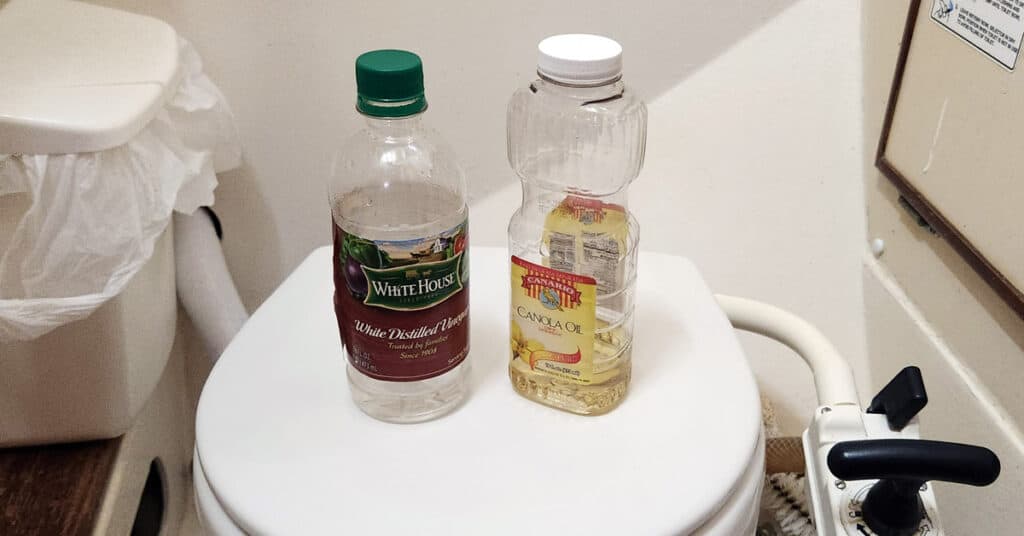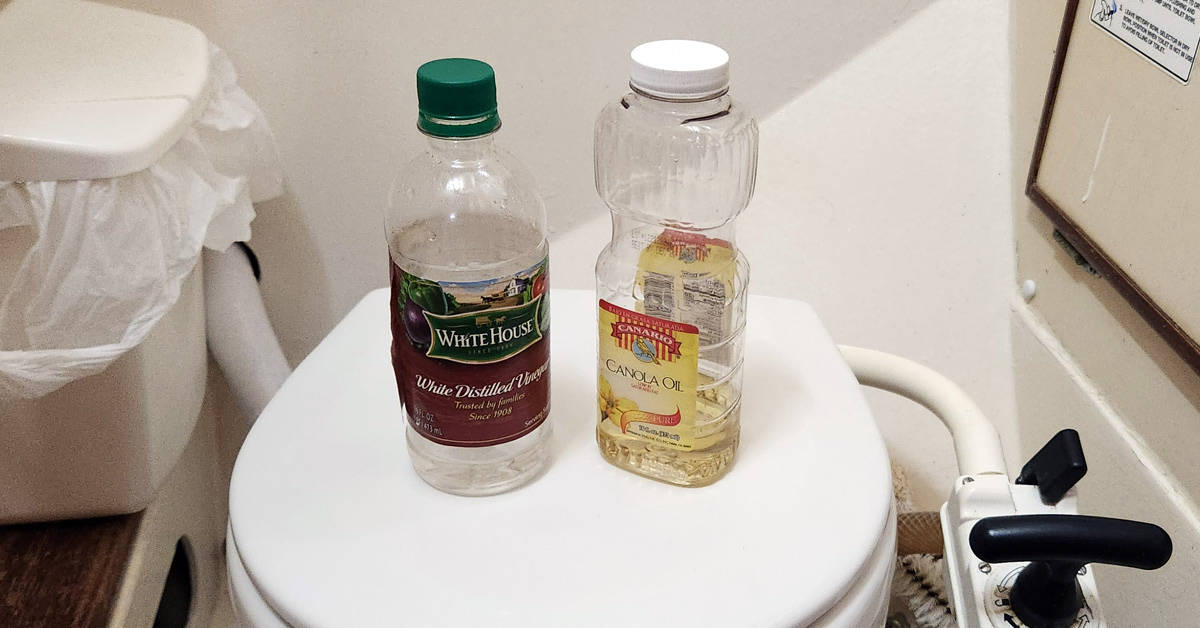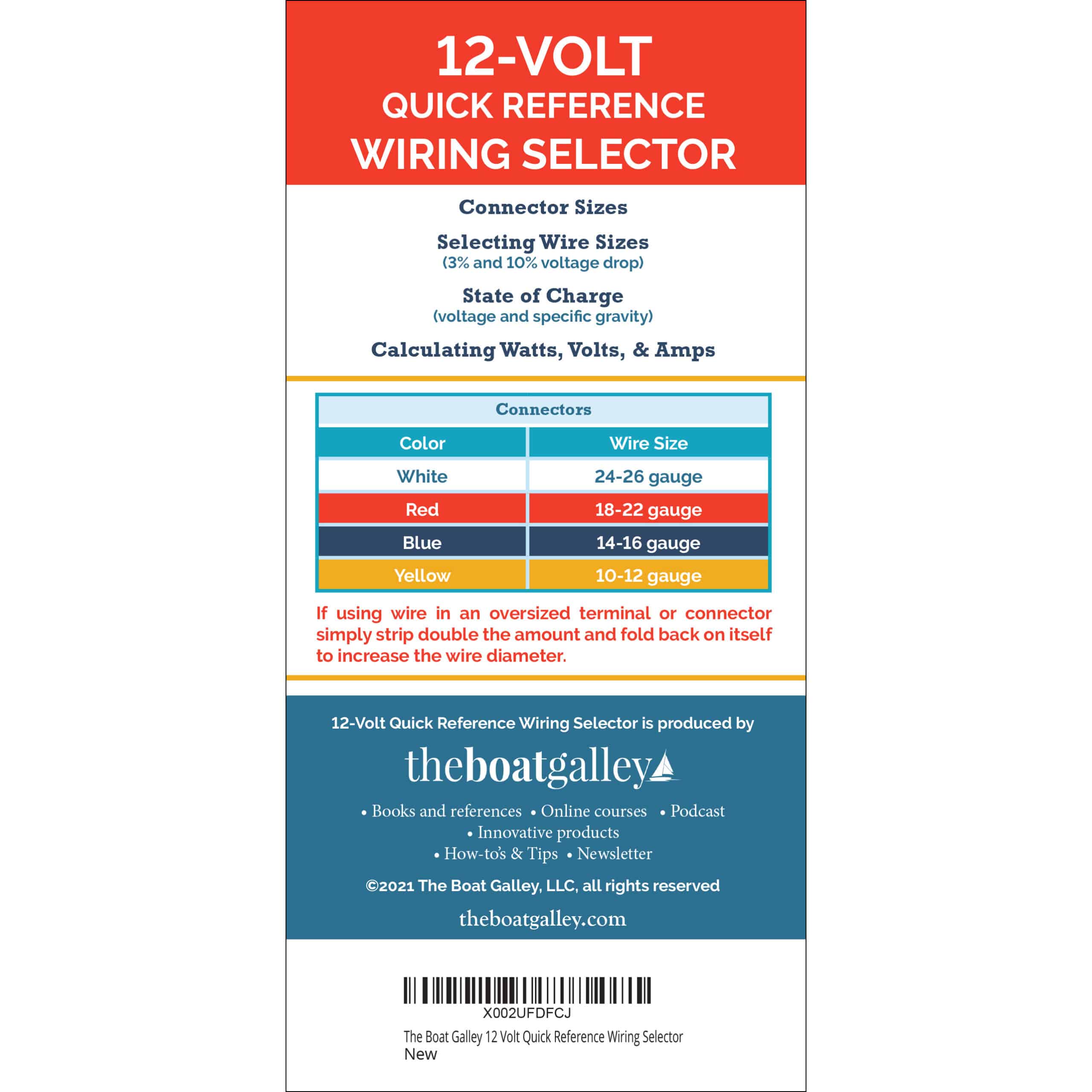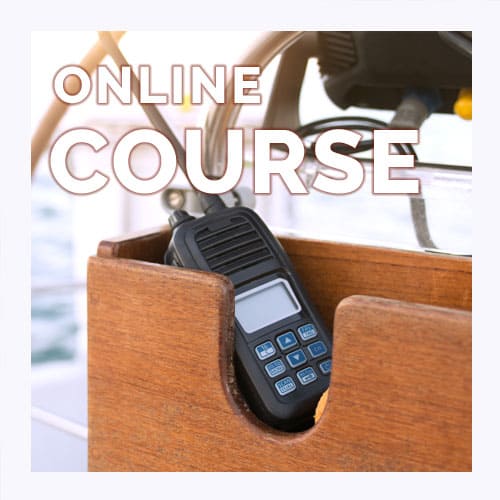Last week, I got an email from Sally O’Neill asking about the vinegar and oil for the head. While Jan and I had talked about buying quantities of both in the Provisioning chapter of The Boat Galley Cookbook, we hadn’t talked about how to use it. Oops!
Lots of cruisers do a “vinegar and oil” treatment every week or so, first pumping white vinegar through to get rid of any build up (urine combines with salt water to make a nasty white “crud” that sticks to the inside of hoses), then using oil to lube the pump.
Put about a cup of white or cider vinegar into the toilet and then pump a couple times to get the vinegar into the hose but don’t pump so much that the vinegar exits the hose. Let sit as long as possible (we like to do this right before going to bed). The mild acid of the vinegar will dissolve the build up to a certain extent — it won’t get 100% — and you’ll considerably delay having to replace the hoses.
Use the head as usual, which will pump the vinegar and crud out. Then add about a half cup of vegetable oil to the bowl and slowly pump it, which will help to lubricate the pump.
A couple of notes: First check the owner’s manual for the head to make sure they don’t recommend some other procedure. Second, realize that this is a maintenence procedure and won’t solve big problems. For really built up hoses, try Marine Digest-It from Unique Natural Products.

Carolyn Shearlock has lived aboard full-time for 17 years, splitting her time between a Tayana 37 monohull and a Gemini 105 catamaran. She’s cruised over 14,000 miles, from Pacific Mexico and Central America to Florida and the Bahamas, gaining firsthand experience with the joys and challenges of life on the water.
Through The Boat Galley, Carolyn has helped thousands of people explore, prepare for, and enjoy life afloat. She shares her expertise as an instructor at Cruisers University, in leading boating publications, and through her bestselling book, The Boat Galley Cookbook. She is passionate about helping others embark on their liveaboard journey—making life on the water simpler, safer, and more enjoyable.
Your VHF can do so much! Learn how to use ALL its features for just $39:












Skylar Walker says
I use vinegar and it’s very effective. Can you explain to me how putting oil into the toilet would manage to lubricate the pump which mechanism is sealed off? Confused but interested. Thanks!
Liz Davis says
I think whether or not your pump is sealed from the contents you’re flushing depends on the type of toilet. My current manual toilet has a pump that’s kind of like a piston inside a chamber. With each stroke, waste is sucked into the chamber and then pushed out the discharge with the other half of the stroke cycle. If the “waste” is actually olive oil, it lubricates the walls of the chamber and “rings” of the piston as it’s pumped. However, when I had an electric toilet with a different pumping mechanism, waste only touched the pumping mechanism when the seals had failed.
Annual Salvador Rally says
Nothing like muratic acid to eat every grain of build up. We’ve never had to change our hoses (or had plugged ones) after we discovered this. Vinegar is only 3%, & acid is like 32%
Tania Burton says
I can’t say nothing about pump lubrication, but when our seacock became very stiff, seized actually cup of olive oil pumped in the heads solved the problem brilliantly
CherylAnn Caf says
Your awesome, I do the oil & vinegar. Though didn’t know about the marine digest it.. Thanks I’m ordering today !!
Michael Guelker-Cone says
I use the muriatic acid as well and the oil I use the lube the mechanism definitely makes a difference on my manual toilet. I can hear and feel a difference when pumping the toilet after the oil treatment. The mechanism is less noisy and pumps much smoother.
Frank Collins says
I have in the last few monthe purchased a O’Day 34. Thee seller who I purchased it from had bought it about a year and a half ago. During the time he had it he totally restored the boat and after finishing his wife decided sailing was not for her. Bad for hime , good for me. I found the boat the day it was listed and purchased it. Anyway the head was not used for over a year and I thought for sure that after giving a try it seemed liked the pressure during pumping was just not there. After using a few cups of oil and pumping it works like new. I know it does not replace or take the place of a needed rebuild , but a couple dollars worth of oil has things flowing smoothly. Thanks your the best !
Jennifer Dean Neumann says
Very interesting, thank you. The PO of our boat was a live aboard in a no discharge zone yet the overboard discharge was completely filled with crystals!!!
The Boat Galley says
Oh oh.
Michael Burby says
been doing that for years
SV Rockhopper Suzanne Mummert says
Can this be used in a purasan system?
The Boat Galley says
I don’t know but would check with customer support.
Kimberly Lancashire says
I’ve also heard that Calgon is good for creating a non-stick surface on both the hoses and the tank, or close to it anyway. Do you have any experience with it?
Matt Callaghan says
I hear that oil will float on the surface in the holding tank.. never to be actually evacuated during pumpout… and will build up.. It also seals the top of the water layer sealing out any oxygen which is needed for anaerobic bacteria…I was adding mineral oil to mine… but stopped doing it.
Georgi Wellington says
Dennis Wellington
Jackie Gallia Chamberlain says
We just had an issue this week with ours, and David had to replace the outlet hose. Thanks for the tip. BTW is was nice meeting you and Dave in Boot Key Harbor!
Annette Walker says
Oil into your holding tank is a BAD thing. Ditto what Matt Callaghan said. Oil sits on top (oil and water don’t mix). Pumping out never removes everything.
Dave Skolnick says
Urban legends are fascinating things.
Vinegar can’t hurt and might help. It certainly is good for cleaning the bowl and rim. For keeping crystals out of the hoses the best you can do is flush thoroughly so only water is left in the hose.
Cooking oil on the other hand is nearly useless for lubricating the pump body of a manual toilet. Read the manual. Once or twice a year do the fifteen minute job of properly greasing the o-ring or fiber seal. When the pump starts to squeak again just do it again. If you’re squeamish wear rubber gloves.
Abel Van Staveren says
Be careful with vinegar if you have aluminum parts in the head. We have an aluminum boat and all the thru-hulls and seacocks are aluminum so we have to avoid using vinegar.
Carolyn Shearlock says
Good comment.
Don Koch says
Oil an d vinegar, you can also make salad in it.
Jo-anne Stang says
Does this work for freshwater boats with holding tanks?
Carolyn Shearlock says
The oil is still good for lubrication, but freshwater boats don’t have nearly as much of a problem with salt crystals forming in the hoses. Can’t hurt to do it periodically, but not as urgent a task as when in saltwater.
Gary Odell says
yup used it for years,
Shane Granger says
We do it all the time and it does work a treat
Frank Higgins says
I use fabric conditioner just a couple of capfulls …hey presto.
David L Crow says
Heyyyy!! Sounds like U and your partner have been living The Best Life!!,, I lived on a small 26 ft sail boat n the Keys, years ago,, family is grown now, I’m alone again, bought a Chris Craft Caribbean 35, last winter!!,, N Realy good condition!!,, Needing Seacocks loosened, greased,, is my chore at the moment,, its dry docked, at my home!!,, So not sooo bad!!! Any thoughts on Seacock Maintenance??? Dave 🇺🇸💪🦅🤠❤️✌️🙏
Carolyn Shearlock says
Exercise them at least once a month.